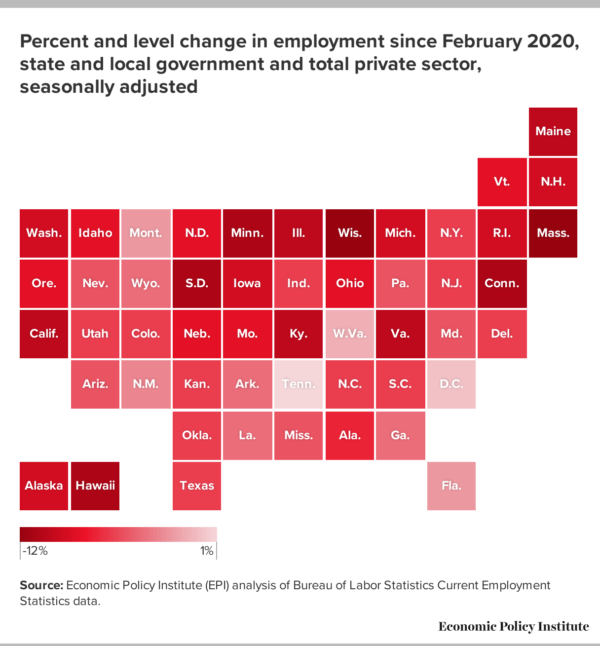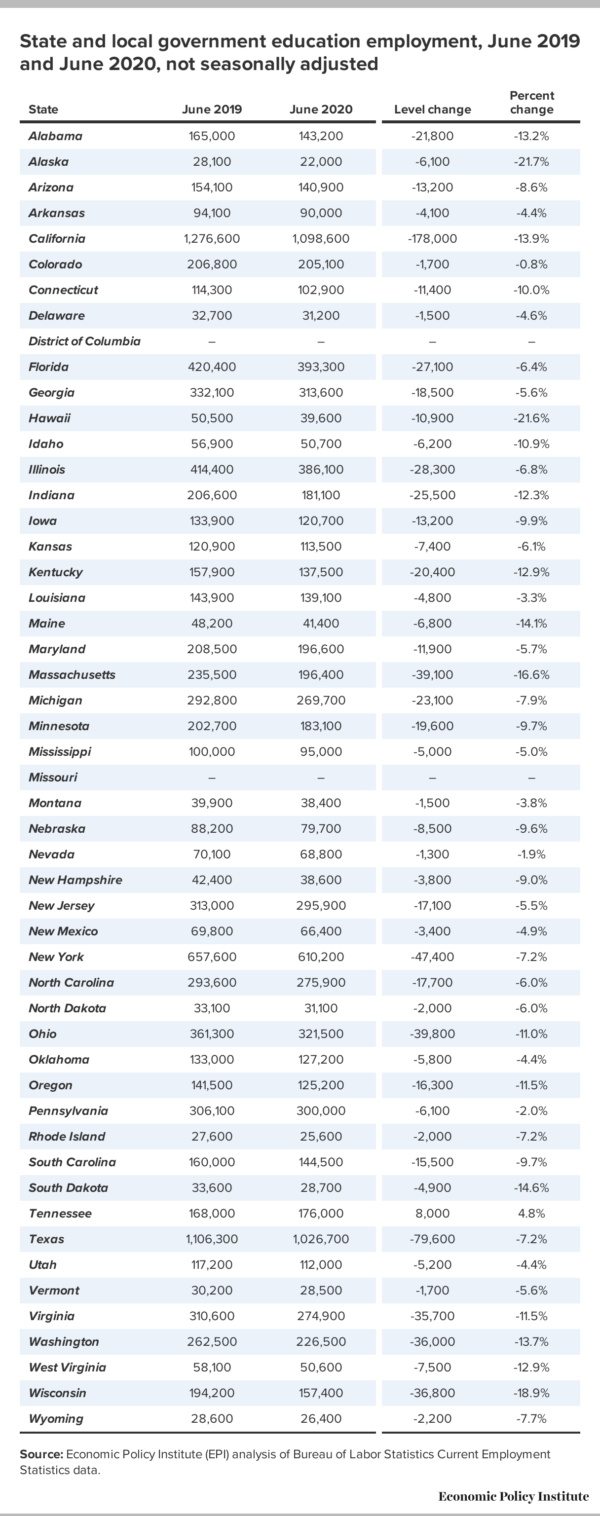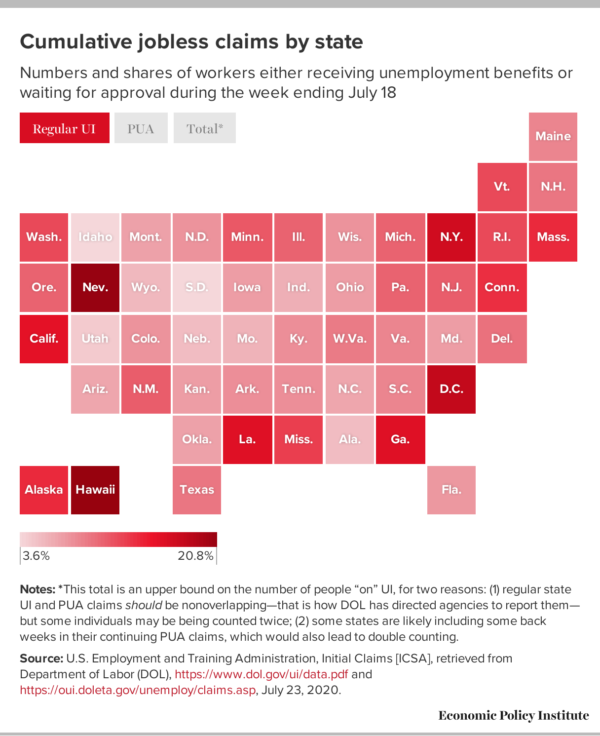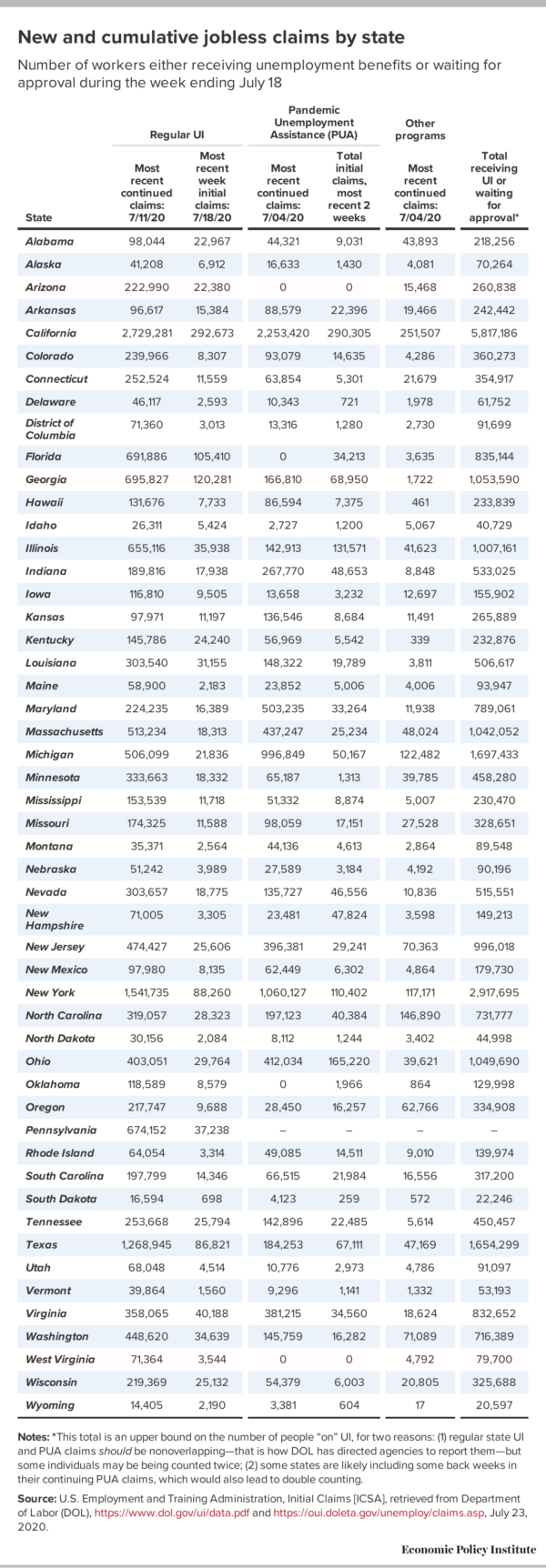Thursday, July 30, 2020
Enlighten Radio:Talkin Socialism: Abuse on the Job in the COVID - Depression
Blog: Enlighten Radio
Post: Talkin Socialism: Abuse on the Job in the COVID - Depression
Link: https://www.enlightenradio.org/2020/07/talkin-socialism-abuse-on-job-in-covid.html
--
Powered by Blogger
https://www.blogger.com/
BEA: Real GDP Decreased at 32.9% Annualized Rate in Q2 [feedly]
http://feedproxy.google.com/~r/CalculatedRisk/~3/T36wrYx6uOY/bea-real-gdp-decreased-at-329.html
From the BEA: Gross Domestic Product, Second Quarter 2019 (Advance Estimate) and Annual Update
Real gross domestic product (GDP) decreased at an annual rate of 32.9 percent in the second quarter of 2020, according to the "advance" estimate released by the Bureau of Economic Analysis. In the first quarter, real GDP decreased 5.0 percent.The advance Q2 GDP report, at minus 32.9% annualized, was close to expectations.
The GDP estimate released today is based on source data that are incomplete or subject to further revision by the source agency. The "second" estimate for the second quarter, based on more complete data, will be released on August 27, 2020.
...
The decrease in real GDP reflected decreases in personal consumption expenditures (PCE), exports, private inventory investment, nonresidential fixed investment, residential fixed investment, and state and local government spending that were partly offset by an increase in federal government spending. Imports, which are a subtraction in the calculation of GDP, decreased.
The decrease in PCE reflected decreases in services (led by health care) and goods (led by clothing and footwear). The decrease in exports primarily reflected a decrease in goods (led by capital goods). The decrease in private inventory investment primarily reflected a decrease in retail (led by motor vehicle dealers). The decrease in nonresidential fixed investment primarily reflected a decrease in equipment (led by transportation equipment), while the decrease in residential investment primarily reflected a decrease in new single-family housing.
emphasis added
Personal consumption expenditures (PCE) decreased at 34.6% annualized rate in Q2, down from 6.9% decrease in Q1. Residential investment (RI) decreased at a 38.7% rate in Q2. Equipment investment decreased at a 37.7% annualized rate, and investment in non-residential structures decreased at a 34.9% pace.
-- via my feedly newsfeed
State and local governments have lost 1.5 million jobs since February: Federal aid to states and localities is necessary for a strong economic recovery [feedly]
https://www.epi.org/blog/state-and-local-governments-have-lost-1-5-million-jobs-since-february-federal-aid-to-states-and-localities-is-necessary-for-a-strong-economic-recovery/
June's national jobs report from the Bureau of Labor Statistics (BLS) showed that there was a 4.8 million increase in jobs, after many states reopened their economies prematurely and accelerated the spread of COVID-19. Despite this uptick in employment, there are still 14.7 million fewer jobs than before the pandemic hit. Of these losses, 1.5 million were in state and local government—a sector which disproportionately employs women and Black workers. In mid-July, BLS released their June state-level jobs report, allowing us to take a closer look at these public-sector losses across the country.
Figure A displays the percent and level change in state and local government employment and private-sector jobs over the course of this recession. In every state and the District of Columbia, with the exception of Tennessee, state and local government employment has fallen since the pandemic took hold. In nine states, more than one in 10 state and local government jobs have been lost since February: Wisconsin (-12.3%), Massachusetts (-11.9%), Connecticut (-11.4%), South Dakota (-11.3%), Hawaii (-10.8%), Minnesota (-10.6%), Illinois (-10.5%), Maine (-10.5%), and Kentucky (-10.2%). Meanwhile, California and Texas have experienced the most public-sector job losses since February: 229,000 (-9.6%) and 112,100 (-6.3%), respectively. Table 1, at the end of this post, displays the state and local employment changes from this map as well as the employment levels in February and June 2020.
These devastating job losses follow a slow and weak recovery for the state and local public sector in the aftermath of the Great Recession. Because of the pursuit of austerity at all levels of government, state and local government employment at the national level only reached its July 2008 level (the prior peak) in November 2019. Just before the pandemic, 21 states and the District of Columbia still had fewer state and local government jobs than in July 2008.

Next, we take a closer look at job losses in the largest subset of state and local government: education. Over half (51.0%) of state and local government workers are employed in public schools, colleges, or universities, and nearly a third (31.4%) are teachers or teaching assistantsi. Public education plays a critical role in our society: not only is education itself a vital good, but schools are also part of our social safety net—through school-based supports such as meals, health, clinics, counseling, and even housing. In normal times, elementary schools also serve as an important source of childcare. This has made schools a prime target for policymakers pushing for a hasty and haphazard reopening, which risks the health of school employees and the families of students (many of whom live with seniors).
Public K-12 education employment has never recovered from the austerity measures that unfolded following the Great Recession and has fallen precipitouslyduring the pandemic. To enable and improve virtual learning, schools will need more resources and staff, not budget cuts. If schools are going to reopen, they should be guided by public health and education experts. This requires enough staff, resources, and personal protective equipment to put the necessary social distancing and safety protocols in place.
Figure B shows the percent and level change in state and local education employment since last June. In 17 states, more than one in 10 jobs in this sector were lost, with more than one in seven lost in Alaska (-21.7%), Hawaii (-21.6%), Wisconsin (-18.9%), Massachusetts (-16.6%), and South Dakota (-14.6%). BLS does not publish data for state and local government employment in Missouri or the District of Columbia. Table 2, at the end of this post, displays the data from this map as well as the employment levels in June 2019 and June 2020.
Please note that the data in Figure B are not seasonally adjusted, because BLS doesn't seasonally adjust state and local government education employment data at the state level. This means it is not directly comparable to the seasonally adjusted state and local government employment data that we have been examining so far. As a result, we will be looking at the changes between June 2019 and June 2020, rather than the changes since February. As schools close for the summer, there naturally would be a seasonal drop in education employment between February and June. By comparing the most recent data to the same month last year, we are cutting through the seasonal noise to measure the employment effects of the pandemic and recession.

There is a clear need for policies that will both address the immediate challenges of the pandemic and set us up for a quick, strong, and sustainable recovery. If federal policymakers do not step in to provide aid to state and local governments facing budget shortfalls, the economic pain will only get worse. Without federal aid, we stand to lose 5.3 million additional jobs—in the private and public sectors—by the end of 2021. This aid would require the federal government to take on additional debt, but that is exactly what we should be doing to ensure a strong recovery.
By not providing federal aid, policymakers would also be sentencing the economy to a prolonged depression, like the one caused by the budget cuts imposed in the aftermath of the Great Recession. We should heed the lessons learned from the last recovery, namely that public-sector cuts translated into private-sector job losses, and that states that did not take the path of austerity had a much stronger recovery.
Right now, state and local government workers are on the front lines of the dual health and economic crises, providing public health services, administering critical economic lifelines like unemployment insurance, and adapting to teaching online. State and local governments face restrictions on how they can borrow to fund these services and declining tax revenues are exacerbating their budget constraints. Substantial federal aid is necessary to prevent cuts to their budgets, services, and staffing.
Long wait times for unemployment insurance claims to be processed—or even just to have questions answered—in the early months of the pandemic demonstrated the importance of having well-resourced and adequately staffed agencies to administer public services when they are desperately needed. This means investing in these services during times of crisis and as we recover, so that the next time disaster strikes we will be ready to help those in need. Aid to state and local governments means ensuring that we still receive range of services that are in the public interest, including trash pickup, keeping roads safe, maintaining sewers, running libraries, and administering support programs.
Finally, nearly three in five (58.8%) state and local government employees are women, compared to fewer than half (47.4%) of private-sector workers. Black workers are also disproportionately employed in this sector, making up 14.1% of the state and local government workforce compared to 11.5% of private-sector employees, as are women of color (20.9% compared to 18.4%). These groups of workers are acutely affected by employment declines since February and would disproportionately suffer from the state and local budget and staffing cuts that are all but guaranteed if the federal government does not step in with substantial aid.


-- via my feedly newsfeed
Congress has failed to extend additional unemployment benefits as millions of workers across the country file new UI claims [feedly]
https://www.epi.org/blog/congress-has-failed-to-extend-additional-unemployment-benefits-as-millions-of-workers-across-the-country-file-new-ui-claims/
The U.S. Department of Labor (DOL) released the most recent unemployment insurance (UI) claims data last Thursday, showing that another 2.3 million people filed for UI benefits during the week ending July 18. Huge swaths of workers in every state are relying on UI for food, rent, and basic necessities. There are 14 million more unemployed workers than jobs. In the face of this economic crisis, Congress has let the extra $600 in weekly UI benefits expire, and now Senate Republicans are proposing reducing the increase to $200, which would cause such a huge drop in spending that it would cost 3.4 million jobs. These benefit cuts will directly harm the workers and their families who need these benefits to weather the pandemic and will cause further economic harm over the next year.
Figure A shows the share of workers in each state who either made it through at least the first round of state UI processing (these are known as "continued" claims) or filed initial UI claims in the following weeks. The map includes separate totals for regular UI and Pandemic Unemployment Assistance (PUA), the new program for workers who aren't eligible for regular UI, such as gig workers.
The map also includes an estimated "grand total," which includes other programs such as Pandemic Emergency Unemployment Compensation (PEUC) and Short-Time Compensation (STC). The vast majority of states are reporting that more than one in 10 workers are claiming UI. Thirteen states and the District of Columbia report that more than one in five of their pre-pandemic labor force is now claiming UI under any of these programs. The components of this total are listed in Table 1.1
Three states had more than 1 million workers either receiving regular UI benefits or waiting for their claim to be approved: California (3.0 million), New York (1.6 million), and Texas (1.4 million). Seven additional states had more than half a million workers receiving or awaiting benefits.
While the largest U.S. states unsurprisingly have the highest numbers of UI claimants, some smaller states have larger shares of the workforce filing for unemployment. Figure A also displays the numbers of workers in each state who are receiving or waiting for regular UI benefits as a share of the pre-pandemic labor force in February 2020. In six states and the District of Columbia, more than one in seven workers are receiving regular UI benefits or waiting on their claim to be approved: Hawaii (20.8%), Nevada (20.7%), the District of Columbia (17.9%), New York (17.1%), Louisiana (15.9%), Georgia (15.8%), and California (15.5%).
Eight states reported that more than one in ten workers are currently claiming PUA, underscoring the importance of extending benefits to those who would otherwise not have been eligible: Michigan (21.2%), Maryland (16.4%), Hawaii (14.0%), California (13.0%), New York (12.3%), Massachusetts (12.1%), Nevada (11.7%), and Rhode Island (11.4%). Pennsylvania reported that 3.8 million workers have claimed PUA, but that would constitute nearly 60% of the state's workforce, so this is almost definitely misreporting. Arizona did not report any continuing PUA claims for the week ending July 4, which is also likely misreporting since they had reported 2.3 million for the prior week.

As we look at the aggregate measures of economic harm, it is also important to remember that this recession is deepening racial inequalities. Black communities are suffering more from this pandemic—both physically and economically—as a result of, and in addition to, systemic racism and violence. Both Black and Hispanic workers are more likely than white workers to be worried about exposure to the coronavirus at work and bringing it home to their families. These communities, and Black women in particular, should be centered in policy solutions. Cutting off the $600 UI benefit will deepen existing racial inequalities, since Black and Hispanic workers have higher unemployment rates than white workers.
In addition to extending the additional weekly $600 benefit that they have allowed to expire, which will help workers in the immediate term and support millions of jobs, Congress should provide substantial aid to state and local governments. Without this aid, a prolonged depression is inevitable, especially if state and local governments make the same budget and employment cuts that slowed the recovery after the Great Recession. More than five million workers would likely lose their jobs by the end of 2021, harming women and Black workers in particular since they are disproportionately likely to work for state and local governments.
We should despair for the millions who have lost their jobs and for their families, and our top priority as a country should be protecting the health and safety of workers and our broader communities by paying workers to stay home when possible, whether that means working from home some or all of the time, using paid leave, or claiming UI benefits. When workers are providing absolutely essential services, they must have access to adequate personal protective equipment (PPE) and paid sick leave. The current spike in coronavirus cases across the country—and subsequent re-shuttering of certain businesses—show the devastating costs of reopening the economy prematurely.

Enjoyed this post? Sign up for the Economic Policy Institute's newsletter so you never miss our research and insights on ways to make the economy work better for everyone.
Notes
1. That total is really more of an upper bound, and you should exercise caution when interpreting it for three reasons: (1) It includes initial claims, which represent people who have not yet made it through the first round of processing; (2) Some individuals may be being counted twice. Regular state UI and PUA claims should not be overlapping—that is how DOL has directed state agencies to report them—but some states may be misreporting; (3) Some states are likely including some back weeks in their continuing PUA claims, which would also lead to double counting (the discussion around Figure 3 in this paper covers this issue well). Those limitations are the reason that we have so far hesitated to publish this estimate of total claims by state. DOL has worked to overcome misreporting issues and has had enough success that we are now comfortable enough to report the totals here. However, it is clear that there is still some misreporting. Unless otherwise noted, all numbers are as reported by DOL. In this post, I drop the reported PUA (and total) claims for Pennsylvania from the figure and table, since they reported more than 3 million PUA claims to DOL (more than half of their labor force!) despite their Office of Unemployment Compensation reporting that they have only received 1.5 million PUA claims.
-- via my feedly newsfeed
Tuesday, July 28, 2020
Without Boost in Next COVID-19 Relief Bill, Puerto Rico Faces Deep Food Aid Cuts [feedly]
https://www.cbpp.org/blog/without-boost-in-next-covid-19-relief-bill-puerto-rico-faces-deep-food-aid-cuts
Nearly 1.5 million Puerto Rico residents, including more than 300,000 children, are facing deep cuts in food assistance in August, but the new Senate Republican economic relief plan doesn't include more food aid for Puerto Rico. While the House-passed Heroes Act includes a modest increase in nutrition funding for Puerto Rico, it falls short of Governor Wanda Vázquez Garced's request. Without sufficient additional food aid, more than a million U.S. citizens in Puerto Rico will face these food assistance losses while also grappling with COVID-19 and its severe economic impact.
a
-- via my feedly newsfeed
Spanish Unemployment Rises Above 15%, With Worse to Come [feedly]
https://www.bloomberg.com/news/articles/2020-07-28/spanish-unemployment-rises-above-15-with-worse-to-come
Spain's unemployment rate rose in the second quarter, a harbinger of the bleak months ahead for one of Europe's most troubled labor markets.
The increase in jobless reflects the fallout from the strictest part of the country's lockdown to deal with the coronavirus. The full economic damage will be revealed on Friday, when data is expected to show that output contracted by more than 16% in the three months through June.
Jobless Hit
Spain's unemployment rate is going to spike again this year
Source: INE, Bloomberg surveys
While the economy has gradually been opening up, the fragile recovery is facing major hurdles. Outbreaks of the virus in some regions have led to a clampdown on many activities, and the outlook continues to worsen for the economically vital tourism sector. U.K. Prime Minister Boris Johnson has ordered those returning from Spain to be quarantined for 14 days, a major blow to an industry that relies greatly on British travelers.
The second-quarter data showed that the number of jobless in the euro-area's fourth-largest economy increased by 55,000 to 3.37 million workers. That lifted the unemployment rate to 15.33% from 14.4%. Youth unemployment jumped more than 6 percentage points to almost 40%.
Spain already had one of the developed world's highest unemployment rates before the crisis because of entrenched structural problems in the labor market. The economic crisis has reversed some of the recent improvements, and worse may be to come.
The country's central bank expects the rate to spike as high as 24% this year in a worst-case-scenario, and the institution's economists don't see it falling below 17% for at least two years.
The economy may shrink more than 10% this year, according to some forecasts, compared with about 8% for the euro area as a whole.
The latest jobless figures underplay the massive damage to the labor market that's already occurred. The statistics office said they doesn't reflect the high number of workers -- almost 1.1 million -- who became inactive. During Spain's strict confinement, many workers were unable to actively look for work, so aren't technically defined as unemployed.
The government rolled out an extensive furlough program to try to limit the damage. There were around 1.75 million workers on it as of July 1, Social Security Minister Jose Luis Escriva said in an interview with Bloomberg News earlier this month. Those furloughed workers are not counted in the jobless figures since they are temporarily suspended.
But recent flare ups in cases of Covid-19 in economically-important regions such as Catalonia have dimmed the outlook for furloughed workers. Tens of thousands of small businesses across the country aren't expected to survive until the end of the year.
-- via my feedly newsfeed